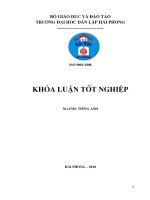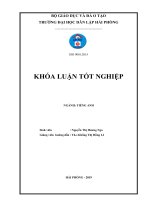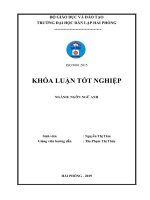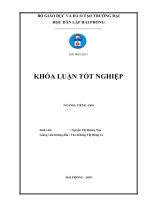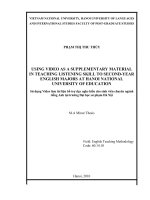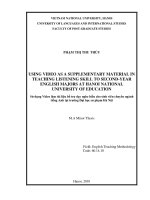A study on common pronunciation mistakes faced by first year english majors at vietnam national university of agriculture
Bạn đang xem bản rút gọn của tài liệu. Xem và tải ngay bản đầy đủ của tài liệu tại đây (960.88 KB, 75 trang )
VIET NAM NATIONAL UNIVERSITY OF AGRICULTURE
FACULTY OF EDUCATION AND FOREIGN LANGUAGES
BA THESIS
A STUDY ON COMMON PRONUNCIATION
MISTAKES FACED BY FIRST-YEAR ENGLISH
MAJORS AT VIETNAM NATIONAL UNIVERSITY OF
AGRICULTURE
NGHIÊN CỨU NHỮNG LỖI PHÁT ÂM PHỔ BIẾN CỦA
SINH VIÊN NĂM NHẤT NGÀNH NGÔN NGỮ ANH
TẠI HỌC VIỆN NÔNG NGHIỆP VIỆT NAM
Student
: NGUYEN THI ANH
Student code
: 621253
Ma jor
: ENGLISH
Supervisor
: TRAN THANH PHUONG, M.A
Hanoi – 2021
VIET NAM NATIONAL UNIVERSITY OF AGRICULTURE
FACULTY OF EDUCATION AND FOREIGN LANGUAGES
BA THESIS
A STUDY ON COMMON PRONUNCIATION
MISTAKES FACED BY FIRST-YEAR ENGLISH
MAJORS AT VIETNAM NATIONAL UNIVERSITY OF
AGRICULTURE
NGHIÊN CỨU NHỮNG LỖI PHÁT ÂM PHỔ BIẾN CỦA
SINH VIÊN NĂM NHẤT NGÀNH NGÔN NGỮ ANH
TẠI HỌC VIỆN NÔNG NGHIỆP VIỆT NAM
Student
: NGUYEN THI ANH
Student code
: 621253
Major
: ENGLISH
Supervisor
: TRAN THANH PHUONG, M.A
Hanoi – 2021
CERTIFICATE OF ORIGINALITY
I, the undersigned, hereby certify my authority of the study project report
entitled “A STUDY ON COMMON PRONUNCIATION MISTAKES
FACED
BY
FIRST-YEAR
ENGLISH
MAJORS
AT
VIETNAM
NATIONAL UNIVERSITY OF AGRICULTURE” submitted in partial
fulfillment of the requirements for the degree of Bachelor in the English
Language. Except where the reference is indicated, no other person‟s work has
been used without due acknowledgement in the text of the thesis.
Hanoi, 2021
Nguyen Thi Anh
Approved by
SUPERVISOR
(Signature and full name)
Date: ……………………
i
ACKNOWLEDGEMENT
To complete this paper, I have been lucky to receive invaluable
contributions and kind help from many individuals.
Foremost, I would like to express my special sincere and thanks to my
supervisor, Ms. Tran Thanh Phuong, M.A for her indispensable support,
suggestions, advice and detailed comments, which helped to complete this study
successfully.
With deepest gratitude, I also would love to show my deep thankfulness
to all my teachers at the Faculty of Education and Foreign Languages, Vietnam
National University of Agriculture, who have imparted me useful knowledge to
complete this research,
I am so thankful to students of K65 at the Faculty of Education and
Foreign Languages for their whole-heart participation in the study.
Last but not least, I would like to give my heartfelt thanks to my family
and friends who always encourage and inspire me to complete this thesis.
Sincerely,
ii
TABLE OF CONTENTS
CERTIFICATE OF ORIGINALITY ..................................................................... i
ACKNOWLEDGEMENT .................................................................................... ii
TABLE OF CONTENTS ..................................................................................... iii
ABSTRACT .......................................................................................................... v
LIST OF ABBREVIATION ................................................................................ vi
LIST OF TABLES AND FIGURES ................................................................... vii
PART 1: INTRODUCTION.............................................................................. 1
1.1. Rationale for the study ................................................................................... 1
1.2. Aims and objectives of the study ................................................................... 2
1.3. Research questions ......................................................................................... 2
1.4. Scope of the study .......................................................................................... 3
1.5. Significance of the study ................................................................................ 3
1.6. Design of the study......................................................................................... 3
PART 2: DEVELOPMENT ............................................................................... 5
CHAPTER 1: LITERATURE REVIEW .......................................................... 5
1.1. Review of the previous studies ...................................................................... 5
1.1.1. Review of the previous study: Abroad ........................................................ 5
1.1.2. Review of the previous study: At home ...................................................... 6
1.2. Review of theoretical background ................................................................. 7
1.2.1. Pronunciation .............................................................................................. 7
1.2.2. Mistakes in language learning ..................................................................... 8
1.2.3. Consonant .................................................................................................. 10
1.2.4. Ending sounds ........................................................................................... 13
1.2.5. Word-stress................................................................................................ 15
1.3. Summary ...................................................................................................... 18
CHAPTER 2: METHODOLOGY ................................................................... 19
2.1. Research methodology ................................................................................. 19
2.2. Research setting/ context.............................................................................. 19
iii
2.3. Data collection.............................................................................................. 20
2.3.1. Data collecting instruments ....................................................................... 20
2.3.2. Data collecting procedure ......................................................................... 22
2.4. Data analysis ................................................................................................ 22
2.5. Summary ...................................................................................................... 23
CHAPTER 3: FINDINGS AND DISCUSSION ............................................. 24
3.1. Results collected from the survey questionnaire ......................................... 24
3.1.1. Students‟ awareness of English pronunciation ......................................... 24
3.1.2. Frequency and student‟s pronunciation mistakes ..................................... 28
3.1.3. Students‟ opinion on pronunciation solutions ........................................... 34
3.2. Results collected by using the recording...................................................... 35
3.2.1. Common consonant errors ........................................................................ 36
3.2.2. Common errors related to word stress ...................................................... 39
3.3. Summary ...................................................................................................... 40
3.4. Suggesting some solutions to improve pronunciation skills ........................ 41
3.4.1. Suggested some solutions for individuals ................................................. 41
3.4.2. Suggested some solutions for teaching pronunciation .............................. 45
PART 3: CONCLUSION ................................................................................. 50
1. Recapitulation.................................................................................................. 50
2. Limitation of the study .................................................................................... 51
3. Recommendations/ suggestions for further study ........................................... 51
REFERENCES .................................................................................................... 53
APPENDIX 1 ...................................................................................................... 56
APPENDIX 2 ...................................................................................................... 60
APPENDIX 3 ...................................................................................................... 63
iv
ABSTRACT
Pronunciation is an important skill that greatly affects the effectiveness of ESL
learners. However, the reality shows that mispronunciation is still a big obstacle
for learners in general and VNUA‟s students in particular. This has much
influence on their learning other skills such as: listening, speaking, reading, as
well as creating many limitations in conversing with native speakers. The aimed
research was to identify the common pronunciation mistakes made by first-year
English majors at VNUA, then suggest to the students of English in general and
English-majored freshmen in particular, some ways to improve their
pronunciation as much as possible. The data collection was collected from 80
English-majored students of K65 at VNUA and then 20 students were asked to
record their pronunciation. The data analysis indicated that the students tend to
make mispronunciations with some consonants, ending sounds, and stress.
However, they still haven‟t had any effective methods to improve their
pronunciation errors. Therefore, the author as a foreign language learner wishes
to partly help the first-year students to pronounce English better.
v
LIST OF ABBREVIATION
VNUA
Vietnam National University of Agriculture
ESL
English Second Language
L2
Second Language
EFL
English Foreign Language
vi
LIST OF TABLES AND FIGURES
Table 2.1. The Consonants of English ................................................................ 13
Table 2.2. Percentage of consonant sounds faced by first-year students ............ 30
Table 2.3. Percentage of ending sounds faced by freshmen ............................... 31
Table 2.4. Students‟ opinions for applying techniques to improve
pronunciation ...................................................................................... 34
Table 2.5. List of common pronunciation mistakes committed by the
students................................................................................................ 35
Table 2.5. Number of students producing in sound omission............................. 36
Table 2.7. Number of students producing in sound deviations........................... 38
Table 2.8. Number of students get trouble with word stress .............................. 39
Chart 2.1: Students‟ favorite skill in English ...................................................... 24
Chart 2.2: The most important factor in speaking English ................................. 25
Chart 2.3: Informants‟ opinion about the role of pronunciation ......................... 26
Chart 2.4: Student‟s interest in pronunciation .................................................... 26
Chart 2.5: The aims of the English pronunciation .............................................. 27
Chart 2.6: The time for practicing pronunciation .............................................. 28
Chart 2.7: Student‟s frequency of making mispronunciation ............................ 29
Chart 2.8: The common pronunciation mistakes made by students ................... 29
Chart 2.9: Sound pairs often confused by first-year English majors .................. 32
Chart 2.10: Students‟ opinion about word stress. ............................................... 33
Chart 2.11: Student‟s knowledge of the rule of putting stress ............................ 33
vii
PART 1: INTRODUCTION
1.1. RATIONALE FOR THE STUDY
In the period of integration with the current globalization trend, foreign
languages play a very important role, being a means for exchanging information
and connecting people all over the world. It is considered effective support for
the building of the global common house.
English is considered an international language, the need for mastery and
use is greater and greater. Understanding its importance, Vietnam, a country in
the stage of development, opens the door to the outside world so learning and
using English is more and more necessary than ever. In recent years, the number
of people learning English has increased significantly. However, to speak
fluently like a native speaker can be an elusive goal because most Vietnamese
still lack confidence when communicating with foreigners, they can‟t pronounce
Standard English, which is a hindrance in communication.
The significance of pronunciation in the EFL was also emphasized by
Celce-Murcia, Brinton & Goodwin (1996:17) that learners‟ English grammar
and vocabulary would be rendered useless if their pronunciation was below the
threshold for permission of non-native English speakers. Also according to
Fangzhi (1998) pronunciation affected the transmission of messages, this is
considered the highest goal of learners in any foreign language. Thus, learners‟
communicative
competence
is
directly
related
to
pronunciation,
so
pronunciation is considered the key in verbal communication.
At the Vietnam National University of Agriculture, most English-majored
freshmen still have many mistakes in pronunciation. If English learners want to
communicate fluently, they must adjust their mispronunciation as soon as
possible, especially when they are freshmen at university. They make a lot of
1
mistakes in using word and sentence stress, intonation, linking sound, and
pronouncing some hard consonants, ending sounds, and so on. If there are no
methods and solutions to improve, this will become one of the biggest barriers
that make students lack confidence in communicating and pursuing jobs related
to the English field in the future.
From the reasons I have mentioned above, I decided to concentrate on this
study entitled “A study on common pronunciation mistakes faced by first-year
English majors at the Vietnam National University of Agriculture”. Hopefully,
this research after completion can partly help foreign language learners break
through difficult barriers and can master this language easily to have a
successful conversation.
1.2. AIMS AND OBJECTIVES OF THE STUDY
This research was aimed to investigate the most common pronunciation
mistakes made by first-year English-majored students at VNUA. Specifically,
the study was conducted with the aim of finding out what the most common
mispronunciation made by first-year English majors at VNUA when speaking
English. Moreover, the researcher would like to offer some solutions to help
English learners in particular and English-majored freshmen improve their
pronunciation skills in the best way.
1.3. RESEARCH QUESTIONS
This aim of paper could be achieved through the following research
questions:
Research question 1: What are the common pronunciation mistakes
committed by first-year English majors at VNUA?
Research question 2:
What are solutions to help English-majored
freshmen at VNUA improve their pronunciation?
2
1.4. SCOPE OF THE STUDY
The scope of phonetic studies was a fairly broad field of study. There are
many aspects related to pronunciation issues including consonants, vowels,
linking sounds, stress, and intonation, elision, assimilation, and so on. Because
of the limitations of time, knowledge, ability, experience as well as references,
this study could not cover all aspects of pronunciation. Thus, the thesis only
focused on realizing pronunciation mistakes that English-majored freshmen at
VNUA often face. The writer paid much attention to three issues consisting of
some consonants, ending sounds and stress errors. That was what a freshman in
English-majored students at VNUA encountered while they pronounced
English. Hence, this study took place from 1/3/2021 to 30/6/2021 with the
participation of 80 English-majored students randomly from five classes
(including 15 participants each class from K65ENGA to K65ENGC, 20
participants from K65ENGE) of K65 at VNUA.
1.5. SIGNIFICANCE OF THE STUDY
This study coped with common pronunciation mistakes encountered by
students and identifies solutions to improve English pronunciation. After this
study was completed, it helped a significant portion of students improve and
optimize their mastery of English pronunciation. Besides, it also supported
lecturers at the Faculty of Education and Foreign Languages to have suitable
strategies for these types of mistakes in teaching students. In addition, this
research would be useful material for non-English major students at VNUA in
improving their pronunciation skills.
1.6. DESIGN OF THE STUDY
The thesis is divided into 3 main parts:
3
PART 1: INTRODUCTION gives information about the rationale, the aims, the
objectives, the research questions, the scope, the significance, and the design of
the study.
PART 2: DEVELOPMENT includes three chapters:
Chapter 1: Literature review, the researcher begins with the previous studies
related to the proposed research by several researchers. Then the key theoretical
background that the study is based on mentioned.
Chapter 2: Methodology, the detailed description of the methodology applied in
the study.
Chapter 3: Findings and discussion, the researcher analyzes the data acquired to
answer the research questions.
PART 3: CONCLUSION presents a brief summary of some main points in the
thesis.
4
PART 2: DEVELOPMENT
CHAPTER 1: LITERATURE REVIEW
The target of this section is to review the previous studies relevant to the
research topic as well as explain the theory applied by providing some key
definitions, which are appropriate to this study. The background knowledge will
help readers have an overview of the theoretical background of pronunciation.
Therefore, it will help students to realize the importance of English
pronunciation and find out the pronunciation blunders they often obtain.
1.1. REVIEW OF THE PREVIOUS STUDIES
1.1.1. Review of the previous study: Abroad
Farrah and Halahlah (2020), Pronunciation problems among Palestinian
English major students in Hebron University investigated the pronunciation
mistakes committed by Palestinian English majors in Hebron University. The
sample of the study consisted of 120 English majors from Hebron University.
The researchers used two instruments to collect data: a questionnaire and a
record pronunciation test. The result of the study revealed that the cause of
mispronunciation might be attributed to Arabic interference and suggested some
solutions to these pronunciation problems.
Ababneh, I. (2018) studied to point out the challenges in English
pronunciation faced by Arab students. The participants were divided into 2
groups: The first group was students in English majors; the second group was a
group of students in Arabic majors. Research results showed that students in
group 1 made fewer errors than students in group 2 who have been trained, but
both groups have errors in orthography, stress, and intonation. This proved that
Arabs in general have problems with pronunciation mistakes.
5
In short, overseas studies have discovered pronunciation errors
encountered by students, but they are not suitable with Vietnamese students, so
in this study, it will be revealed.
1.1.2. Review of the previous study: At home
In Common Pronunciation Problems of Vietnamese Learners of English
by Tam, H. (2005), the researcher collected data on 51 students who completed
four years of English in the English department, and data was collected through
an oral exam in the form of an oral questionnaire. During the exam, students are
asked to present a talk about a specific topic in approximately five minutes.
While listening to the students‟ talk, the researcher recorded the errors related to
pronunciation. The result showed that there are three common errors of students
in pronouncing English consonants and the main element leading to Vietnamese
mispronouncing is their native language. This research was only conducted with
a limited number of students and has not presented any solutions.
The report entitled “Some Common Pronunciation Problem Facing
Vietnamese Learner of English” by Nguyen Tien Dung (2014) indicates that
that the complexity of vowels, the difference between consonant positions,
consonant clusters, and grammatical ending s make Vietnamese speakers engage
many obstacles in learning English pronunciation. This research has not shown
any solution to this problem.
The study entitled “Mistake or Vietnamese English” was written by
Duong Thi Nu (2009) points out that the Vietnamese learner mispronouncing is
due to “inadequate knowledge of the articulation of the sounds and, more
importantly, the interference of the mother tongue”. Moreover, she also said that
there are three reasons why learners‟ pronunciation mistakes: influence by the
native language; inadequate practice and misperception. However, this study
only just focuses on the mistakes of Vietnamese people when pronouncing the
6
four English sounds /ʃ/, /ʒ/, /tʃ/ and /dʒ/. So, the study related- issues in a wider
range will be explored more closely in this thesis.
In summary, only a very small aspect of pronunciation has been found by
previous researchers. That is with a narrow context of consonants. With a
broader context, this study will reveal the mistakes that learners‟ English
pronunciation encounters and suggest some suitable solutions to help improve
learners' pronunciation.
1.2. REVIEW OF THEORETICAL BACKGROUND
1.2.1. Pronunciation
1.2.1.1. Definition
Pronunciation is an important term widely used in second language
acquisition. There are many diverse sources of information about the definition
of pronunciation.
Pronunciation, as defined by Oxford Advanced Learner’s Encyclopedic
(1992:718), is “the way in which a language is spoken”. According to Penny
(2008), pronunciation is a sound system including the sounds of language,
phonetics; stress and rhythm; intonation; sound combination and linking sound.
Another definition about pronunciation, Dalton (1994:1) also assumes that
pronunciation in general terms is the production of significant sound in two
senses. First, the sound is critical because it is used as part of a particular
language code, and so, we can talk about the distinctive sounds of English,
French, Thai, and other languages.
Adapting from these definitions, the researcher would like to view
pronunciation as how to read a word or the sound produced from the muscles of
the mouth in a certain language.
1.2.1.2. Significance of pronunciation
The role of pronunciation in foreign and second language acquisition has
been widely acknowledged. It plays a very important role in learning a language
7
Nation & Newton (2009:75) emphasizes the vital role of pronunciation for L2
learners, especially ESL learners. They explained that the first crucial element to
understand a language is good pronunciation. Fangzhi (1998) also shares the
same idea, it is important to pay attention to pronunciation since it results in
whether or not someone's message can be passed or not by other people.
A statement presented about the role of pronunciation that pronunciation
is the sound of the language or phonology; stress and rhythm; and intonation and
includes the role of individual sounds and suprasegmental and segmental
sounds” (Richard, 1985). Fraser (2000) also states that English speakers that
make grammar mistakes or have a lack of vocabulary are still intelligible and
understood by the listeners rather than English speakers that make
pronunciation.
To sum up, pronunciation plays such an essential role in L2 acquisition.
This practice not only provides L2 learners with the formation of a standard
language but also is the indispensable means of conveying messages to listeners.
Furthermore, pronunciation is also a prerequisite for the extension of other skills
in the process of mastering a language.
1.2.2. Mistakes in language learning
1.2.2.1. The Distinction between Error and Mistake
In spite of the fact that many dictionaries claim that a mistake is
synonymous with an error, arguments concerning error and mistake have
emerged among researchers.
Brown (1994:56) argues that making mistakes is inevitable in both native
and second languages. The failure to utilize a noun system correctly is a mistake
related to a performance error that is considered a random guess or a “slip”.
Native speakers are normally able to recognize and correct such “lapses” or
mistakes, which are not the result of incompetence but the result of some kind of
8
glitch or temporary imperfection in the process of producing speech.
Hesitations, tongue slips, random intonation, and other production errors by
native speakers also occur in second-language speech. The learner's competence
will be reflected through an error which is a noticeable deviation from the adult
grammar of native speakers. It means that error reveals a portion of the learner‟s
competence in the target language, while the mistake is the learner‟s temporary
impediment or imperfection in the process of utilizing the language.
Another idea about a distinction between a mistake and an error by James
(1998:83) is that “An error cannot be self-corrected, while mistakes can be
corrected if the deviation is pointed out to the speaker. So students who make
mistakes can correct themselves because they know how to correct them”.
If a student cannot self-correct a mistake in his or her own English, but
the teacher thinks that the class is familiar with the correct form, that sort of
mistake is an error.
In short, errors and mistakes are particularly relevant to the language
learning process. A mistake will depend on the quality performance of the
learner while an error is related to the learner's deficient competence. However
they are related to each other so in other words, a type of mistake is an error.
1.2.2.2. Classification of mistakes
In the process of learning any language, making pronunciation mistakes is
inevitable. As in many dictionaries, Adrian (1994:133) also recognizes that a
mistake is “an error” when correctness has no standard for learners to evaluate.
However, each researcher has a different view, so they have divided the types of
errors in many ways.
Pham Dang Binh (2003) classifies error into two main types: common
errors and typical errors. Common errors are those that normally appear at the
beginning of the learning process that any second language learner makes when
learning the same target language. Whereas, errors made by several groups of
9
learners who speak the same native language or live in the same culture are
called typical errors. Those errors include two main types: inter-lingual errors
and culture interference errors.
According to Richard (1971), language errors can be divided into three
main parts: inter-lingual errors, intra-lingual and development errors. Interlingual errors, as he claimed are popular among second language learners, are
errors caused by language transfer. Intra-lingual is errors that reflect common
features of linguistic principles such as grammatical and lexical errors which are
related to non-verbal communication. He also gave the definition of
developmental errors as the result of learners' limited experience trying to
hypothesize about the target language.
In addition to a study related to pronunciation problems found by Ha Cam
Tam (2005:9), the most common errors made by Vietnamese learners are sound
omission, sound deviation and sound insertion.
Furthermore, the few errors that exist among English-speaking learners
have also been shown to omit some similar sounds, mispronouncing some
consonants, and a tendency for all syllables to be equal (Doff, 1998).
In brief, based on the scope of research as well as aspects of
pronunciation, the division of errors is different. Within the scope of the study,
the researcher only focuses on some errors in the range of consonants and word
stress.
1.2.3. Consonant
Consonants play an important role in accents. O‟Connor (1980) assumes
that the difference of accent is mainly the result of differences in the sound of
the vowels; the consonants are pronounced in very much the same way wherever
English is spoken. Therefore, if the vowels you use are not perfect it will not
prevent you from being understood, but if the consonants are imperfect there is a
huge risk of misunderstanding.
10
Kenworthy, J. (1987) also indicates that in the sound system of English,
there are 44 sounds divided into two types that include 24 consonants and 20
vowels. In which 20 vowels are classified into 5 long vowels, 7 short vowels,
and 8 diphthongs.
In short, the phonemic system in English includes both consonants and
vowels, but this study just concentrates on consonants and their classification.
1.2.3.1. Definition
The definition of a consonant can be understood simply as “sound is
blocked by certain parts of the mouth when the air is passing” according to John
(1993).
Roach, P. (2000:10) offers a concise definition of a consonant to “if we
make a sound like s, d it can be felt that we are making it difficult or impossible
for the air to pass through the mouth”.
Additionally, in Better English Pronunciation by O‟Connor (1980), the
term of the consonant can be defined as “consonants are created by vocal organs
with intersecting airstream”. In the same way, Todd (1987:14) also claimed that
“when the airflow is restricted and blocked between the vocal cords and the lips,
a consonant is produced”.
In short, sounds that are “blocked”, “restricted”, “stopped” by the
airstream are called consonants.
1.2.3.2. The classification of consonants
Brinton (2000:23, 24) presents that consonants are classified according to
three main features:
● Manner of articulation: the way in which the organs of speech are used
to produce a speech sound.
Plosive stop: During the production of sounds, the airflow from the lungs is
completely blocked in several places and then released: /p/, /b/, /t/, /d/, /k/, and /g/.
11
Fricative: The flow is slightly suppressed, but not completely blocked: /f/,
/v/, /θ/, /ð/, /s/, /z/, /ʃ/, /ʒ/ and /h/.
Affricate: These sounds begin to be created as breezy tones, with complete
blocking of the airflow or closure of the vocal tract, and end with a barrage of
breath sounds as muted tones: /tʃ/ and /dʒ/.
Nasal: The sound produced with the airflow through the nose: /m/, /n/, and /ŋ/.
Lateral: A speech sound allow air to escape to the sides of the tongue: /l/
Semi-vowel: In approach sound generation, one vocal organ presses close to
another, but the vocal tract is not narrowed to create eddy currents: /j/, /w/, and /r/.
● Places of articulation: The way a speech sound is produced from within
the mouth or throat where the sound is made, consonants include:
Bi-labial: The upper and lower lips approaching or touching each other.
/p/, /b/, /m/, /w/
Labio-dental: the lower lip touches the upper teeth to produce sound. /f/, /v/
Dental: The tip of the tongue is inserted between the upper and lower teeth. /θ/,
/ð/
Alveolar: The tip of the tongue approaches or touches the gingival arch
behind the upper front teeth. /t/, /d/, /s/, /z/, /n/, /l/, /r/
Alveolar - palatal: the tip of the tongue or the part of the tongue touches
the position between the alveolar ridge and the hard palate. /ʃ/, /ʒ/, /tʃ/, /dʒ/
Palatal: the part of the tongue that approaches or touches the hard palate. /j/
Velar: the part of the tongue that approaches or touches the soft palate. /k/,
/ɡ/, /ŋ/
Glottal: space between two vocal cords. /h/
● Voicing: Speech sounds that are produced with or without vibrating of the
vocal cords.
12
Voiced: The sound vibrates vocal cords during speech. /r/, /l/, /w/, /j/, /b/,
/g/, /v/, /d/, /z/, /ð/, /ʒ/, /dʒ/, /m/, /n/, / ŋ/.
Voiceless: The sound is emitted without vibration from the larynx. These
are the sounds produced by the airflow in the oral cavity, not the larynx. /p/, /f/,
/k/,/t/,/θ/, /s/, /ʃ/, /h/, /tʃ/.
Let‟s take a look at the following chart of the English consonants
Table 2.1. The Consonants of English
Place of articulation
Manner of articulation
Stop
Nasal
Flap
Fricative
Affricate
Approximant
voiceless
voiced
voiceless
voiced
voiceless
voiced
Lateral
Retroflex
Glide or
semivowel
Bilabial
p
b
m
Labio
dental
f
v
Interdental
θ
ð
Alveolar
t
d
n
Alveolopalatal
s
z
ʃ
ʒ
tʃ
dʒ
Palatal Velar Glottal
k
g
ŋ
h
l
r
w
y(=j)
w
h
To sum up, English consonant phonemes have been classified into
different categories based on place of articulation, manner of articulation, and
vibration of the vocal cords.
1.2.4. Ending sounds
1.2.4.1. Definition
According to Avery and Ehrlich (1992:155) “Vietnamese has no
consonant clusters in initial or final position”. Thus, “ending sounds” is a
familiar word for English learners. For simple understanding, “ending sounds”
are sounds that appear at the end of a word. It refers to one or more consonants
at the end of the word (final consonant clusters). So the ending sounds are called
13
Codas: “The coda is the final consonant or consonant cluster.” (Barbara and
Brian (1997)).
1.2.4.2. Classification of ending sounds
According to Roach, P. (1991), the types of coda are classified as follows:
● No consonants at the end of words, it has zero coda
● Except for the sounds “h, r, w and j, the other consonants can be
called a coda.
● Two consonants at the end of the word:
Two-consonant clusters at the end of a word, the consonant cluster behind
will be the ending sound.
- Two consonants standing next to each other at the end of a word made up
of the sounds: m, n, ŋ, l, s; for example sink, lamp, six, think
-Two consonants also stand next to each other at the end of a word but
form a small set: s, z, t, d, θ; for example chest, bets, bagged
● Three-consonant clusters at the end of a word:
The final three-consonant clusters are classified into two main categories:
- The first type is when three consonants stand next to each other at the end
of a word; for example helped, bank, twelfth.
- The second type is that more than one final consonant can appear in a
final cluster when combined with one of the voiceless sounds s, z, t, d; for
example fifths, next, lapsed.
● Four-consonant final clusters:
The final four-consonant clusters are classified into two main categories:
- First, they consist of four non-contiguous final consonants at the end of a
word and are arranged in the order pre-final, final, post-final and post-final; for
example twelfth /twelfθs/, prompts /prɒmpts/.
- The second type has a rare occurrence, that is, consists of a final
consonant with three consecutive post-final consonants; for example sixths
/sɪksθs/, texts /teksts/
14
In general, ending sounds can be defined as codas are consonants, they
contain one or more consonants at the end of words, in other words, this is the
final consonant cluster.
1.2.5. Word-stress
1.2.5.1. Definition
In The Structure of Modern English: A Linguistic Introduction, Volume 1
by Brinton (2000:57) “Every word spoken in isolation has at least one stressed
syllable. In other words, the stress associated with a rise in air pressure; an
increase in the activity of the respiratory muscles that push more air out of the
lungs during the pronunciation of a syllable.”
Collins (2003), stress is defined as how strong or weak the sound is
uttered. According to Erik Fudge in English Word Stress (1984:1) is states that
“stress means essentially that one phonological element is singled out within,
longer, phonological elements” and “word-stress, on the other hand, essentially
picks out on syllable within a word”. In another research, Kenworthy (2012:126)
defines stress as an essential feature of word identity in English.
In conclusion, stress is simply understood as the way one syllable is
pronounced with stronger force than the other syllables in the same word. There
are two types of stress: word and sentence stress. This research will only
concentrate on some remarks about English word stress.
1.2.5.2. The basic rule of English word stress
To communicate clearly when you are speaking in English, it‟s important
to stress the correct syllables in each word. In English Phonetics and Phonology
by Roach, P. (2000) is shown some rules of stress in words.
The stressed word must be a word with two syllables or more than two
syllables.
15
Two-syllable words
● The first syllable is stressed
- For most two-syllable nouns and adjectives in English, the stress is put on
the first syllable. For example:
Nouns: center /ˈsentər/, object /ˈɑːbdʒɪkt/, flower /ˈflaʊər/…
Adjectives: happy/ ˈhæpi/, present /ˈpreznt/, clever /ˈklevər/, sporty
/ˈspɔːrti/…
- Verbs containing a short vowel on the second syllable and fínal in one (or
no) consonant; for example „apply‟ /əˈplaɪ/, „arrive‟ /əˈraɪv/, enter/ ˈentər/, open
/ˈoʊpən/…
- In addition, verbs ending in ow have the stress on the first syllable; for
example borrow /ˈbɔːroʊ/, follow /ˈfɑːloʊ/…
● The second syllable is stressed
- Most verbs and prepositions with two syllables are stressed on the second
syllable; for example:
Verbs: relax /rɪˈlæks/, object /əbˈdʒekt/, receive / rɪˈsiːv/, accept /əkˈsept/…
Prepositions: among /əˈmʌŋ/, aside /əˈsaɪd/, between /bɪˈtwiːn/…
- Nouns or adjectives containing long vowels, diphthongs on the second
syllable, or ending in more than one consonant.
Example: belief /bɪˈliːf/, Japan /dʒəˈpæn/, correct /kəˈrekt/, perfume
/pərˈfjuːm/, police /pəˈliːs/…
- Words that have two syllables but the first syllable is a prefix.
Example: unwise /ˌʌnˈwaɪz/, prepare /prɪˈper/, dislike /dɪsˈlaɪk/, redo
/ˌriːˈduː/…
Three- syllable and more than three- syllable words
● The stress placed on the first syllable
- For three-syllable nouns: if the second syllable contains the sound /ə/ or
/i/, the stress will be stressed on the first syllable.
16
